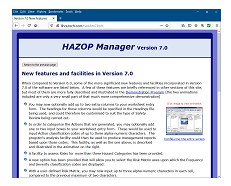History of the HAZOP Manager program
Development of the HAZOP program began in 1985. That was in the days when personal computers were only just becoming accepted as a potentially useful business tool, and a really powerful machine had about 256 KB of memory and a 10 MB hard disk. At that time the program utilised a proprietary integrated package (i.e. word processor, spreadsheet and database).
The program was initially developed as a tool for our own use when conducting Hazop Studies as external consultants. However, a few of our clients, having seen the software in operation, purchased the program for carrying out their own in-house reviews. No serious attempt at marketing the system was made during these early years.
As time progressed, new features and functionality were added to what was initially a very basic software tool. As with many integrated packages, however, the more one attempted to do in terms of incorporating additional facilities, the slower the system performed.
The decision was therefore taken to re-develop the program using a significantly faster compiled language. The language chosen was "C", which at the time seemed most appropriate. It was the native language of the Unix operating system, and that, according to computer pundits at the time, was the future for computing after DOS (Bill Gates obviously had a different vision of the future!). In 1989 the compiled version of the HAZOP program was released, and for the first time a positive effort to market the system to outside companies was made.
This DOS based program was improved and extended during the next few years. In the mid-nineties, however, feedback from users indicated that they found it increasingly tiresome to have to drop back into DOS to conduct their safety reviews, when many of their main-line applications now operated under the newer Microsoft Windows ® platform.
With this in mind, the software was completely re-structured and re-coded using "C++". In 1996 Version 3.0 was released, which was designed to operate under Windows 95® and NT 3.51®. This was followed a few years later by Version 4.0. In addition to incorporating many new features, this latter version took the first steps in meeting the growing requirement for the distribution and retrieval of data electronically, an aspect which has assumed greater importance as time progresses.
In 2000 Version 5.0 included enhanced facilities for the electronic distribution of data mentioned above, such as study reports, study analysis tabulations, and the actions generated during a review. Additional features were also incorporated to increase the versatility of the software, amongst them being more automatic and comprehensive facilities for the export of data to other programs such as Microsoft® Word. A few years later Version 6.0 was released, which amongst many other enhancements included more comprehensive provisions to cater for general safety assessments, such as SIL Analyses, Hazard Identification Reviews, etc. In addition, a unique facility was incorporated to automatically transfer into the study data file the action responses returned in Word Action Documents.
HAZOP Manager V7.0 builds upon the previous releases of the software, containing extensions and enhancements suggested by users, as well as new functionality that we have identified as being useful during our own consultancy work. For example, facilities have been incorporated to optionally increase the number of columns and input boxes to be used during a review, reports can now be generated in multiple formats, the 'Action Sheet' layout can be customized with additional sign-off and comment boxes, and so on. A list of the more significant improvements can be viewed by clicking the image on the left.
As with all software, continued progress and development is important, both to maintain the loyalty of existing customers, and to attract new ones. Future versions will be released in due course, and as has always been the case in the past, existing users will be able to update their programs for a modest upgrade fee.

